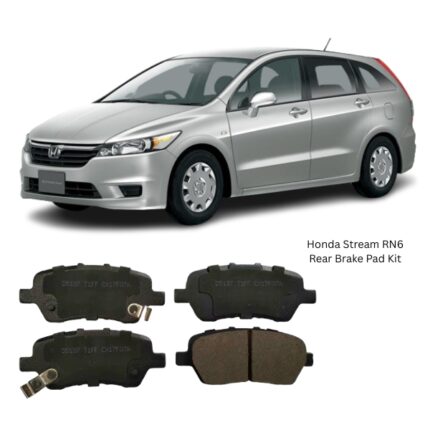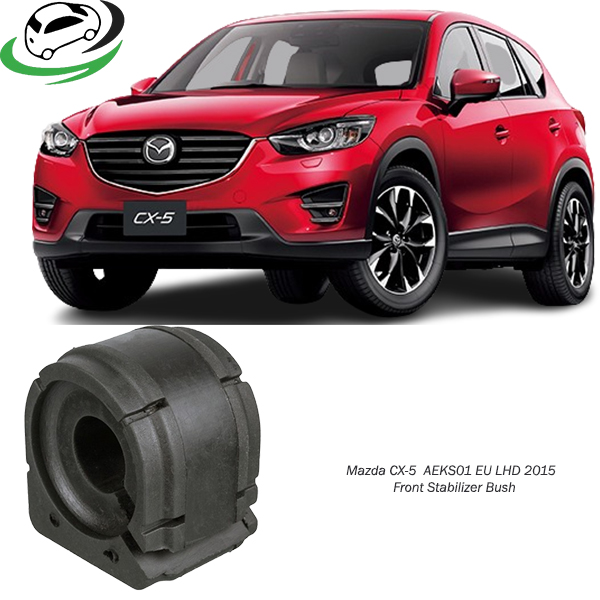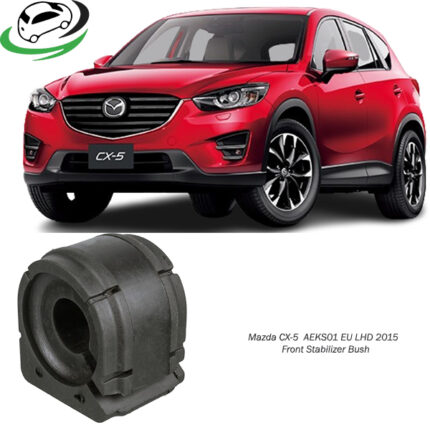Get Mazda CX5 AEKS01 EU LHD 2015 Front Stabilizer Bush KD35-34-156B in Kenya
The front stabilizer bush (or bushing) is a small yet essential component within a vehicle’s suspension system. It connects the front stabilizer bar (also called the sway bar or anti-roll bar) to the car’s chassis, providing a cushion to reduce vibrations, absorb shocks, and minimize the sway or “roll” of the vehicle during turns. By reducing these movements, the stabilizer bush ensures a smoother and more controlled driving experience.
How the Front Stabilizer Bush Works
The stabilizer bush is usually made of durable rubber or polyurethane, designed to be flexible and absorb road vibrations. It acts as a cushion around the stabilizer bar, allowing it to twist and move without metal-on-metal contact. When the vehicle makes a turn, the bush absorbs and disperses the movement, ensuring the stabilizer bar can perform its function of keeping the vehicle level.
- Cushions Vibrations and Noise: The rubber or polyurethane material in the stabilizer bush effectively dampens vibrations from rough roads, ensuring a quieter and more comfortable ride.
- Prevents Excessive Sway: The stabilizer bar is responsible for balancing the vehicle during turns, and the bush ensures this bar stays in place, which prevents excessive body roll.
- Promotes Suspension Longevity: By absorbing shocks and limiting the movements in the suspension, stabilizer bushes help reduce wear on other suspension parts, increasing their lifespan.
Benefits of a Well-Maintained Stabilizer Bush
- Improved Handling: A healthy stabilizer bush maintains the stability of the vehicle, providing better handling and control during turns. This is especially crucial in vehicles with a higher center of gravity.
- Enhanced Comfort: The rubber or polyurethane composition of the stabilizer bush absorbs and reduces road noise and vibrations, providing a smoother and quieter ride.
- Longer Suspension Life: A functioning bush protects other components by absorbing shocks, allowing the stabilizer bar to operate without excess wear and tear.
- Increased Safety: With improved stability and handling, the risk of accidents due to loss of control, particularly during sharp turns or sudden swerves, is reduced.
Common Signs of a Worn Front Stabilizer Bush
A worn or damaged stabilizer bush can significantly affect vehicle handling and stability. Here are some indicators that it may need replacement:
- Excessive Sway or Body Roll: If the vehicle leans more than usual during turns, the stabilizer bush could be worn or cracked, allowing excessive movement of the stabilizer bar.
- Clunking or Rattling Sounds: Loose stabilizer bushes may produce clunking or rattling noises, especially on uneven roads or when going over bumps. This sound is due to the stabilizer bar moving excessively or making contact with other parts.
- Steering Instability: A loose stabilizer bush can impact steering responsiveness, making the car feel unstable or “loose” during cornering.
- Uneven Tire Wear: While uneven tire wear often relates to other suspension issues, worn stabilizer bushes may also contribute, as they can lead to misalignment in the vehicle’s suspension.
- Visual Wear and Tear: During inspections, visible cracking, tearing, or looseness in the stabilizer bush is a clear sign of deterioration and indicates a need for replacement.
Causes of Wear and Tear in Stabilizer Bushes
While stabilizer bushes are designed to be durable, several factors can contribute to their wear over time:
- Age and Use: Rubber bushes degrade with time and exposure to road elements, heat, and engine vibrations. Over time, they harden, crack, or become brittle, reducing their effectiveness.
- Road Conditions: Frequent driving on rough roads, potholes, and unpaved terrain puts extra strain on suspension components, accelerating bush wear.
- Climate: Extreme temperatures can cause rubber to degrade faster. Heat causes rubber to dry out and crack, while cold can make it brittle and more prone to damage.
- Heavy Loads: Vehicles consistently carrying heavy loads put more stress on the suspension, leading to quicker wear on stabilizer bushes.
- Poor Maintenance: Lack of regular suspension checks can lead to unnoticed wear and tear, allowing minor issues with the stabilizer bush to progress until replacement is necessary.
Choosing the Right Front Stabilizer Bush
When replacing a front stabilizer bush, it’s essential to choose the right material for your driving needs:
- Rubber Bushes: Commonly used in many vehicles due to their flexibility and noise-dampening qualities. They’re ideal for everyday driving, providing a smoother and quieter ride.
- Polyurethane Bushes: These are stiffer and more durable, offering better performance for off-road or high-performance vehicles. While they don’t absorb noise and vibration as well as rubber, they last longer and improve handling.
Maintenance Tips for Stabilizer Bushes
- Regular Inspections: During routine servicing, check the stabilizer bush for signs of wear, cracks, or looseness. Early detection of minor wear can prevent major suspension issues later.
- Lubrication: For some types of stabilizer bushes, especially polyurethane, using a specific lubricant can reduce squeaking and improve lifespan. Rubber bushes typically don’t require lubrication, but some vehicles benefit from it.
- Replace in Pairs: If one stabilizer bush shows signs of wear, it’s a good practice to replace both (left and right). This ensures balanced performance and handling on both sides of the vehicle.
- Use Quality Parts: Always opt for high-quality stabilizer bushes from reputable manufacturers. Cheap replacements may save money upfront but can wear out faster and fail under pressure.
- Align with Suspension Maintenance: Whenever there is suspension work, check the stabilizer bushes for wear. Often, issues in the suspension system, like worn shocks or struts, can impact the stabilizer bushes.
Replacement Process (General Overview)
While the exact replacement steps may vary by vehicle, here’s a general overview:
- Lift the Vehicle: Safely lift the vehicle and remove the front wheels to access the stabilizer bar and bush.
- Locate the Bush: Identify the stabilizer bush, typically clamped around the stabilizer bar near the wheel wells.
- Remove the Old Bush: Loosen the clamps or brackets holding the bush in place. Slide out the worn bush.
- Install the New Bush: Fit the new bush around the stabilizer bar, ensuring it aligns properly. Reattach the clamp securely.
- Test Drive: After replacing the bush, test the vehicle to ensure there are no unusual sounds and that handling feels smooth.
Final Thoughts
The front stabilizer bush may seem like a minor component, but it plays a major role in ensuring vehicle stability, comfort, and handling. Proper maintenance, timely inspections, and using quality replacement parts will keep your suspension system functioning optimally and extend the life of your stabilizer bush. Remember, a stable vehicle is a safer and more enjoyable one, making regular attention to this small component well worth the effort.
Follow us on Facebook for more parts.




